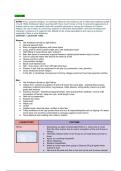Summary
Summary AQA Drama A-level - Yerma - Design notes
ALL Yerma design notes - covering lighting, set (with drawings) & sound ideas for every act/scene, and costumes (with drawings) for every character. Includes references to historical/social context in order to obtain the top marks. I used these to revise for my Drama A-level in 2023 to get an A*.
[Show more]



